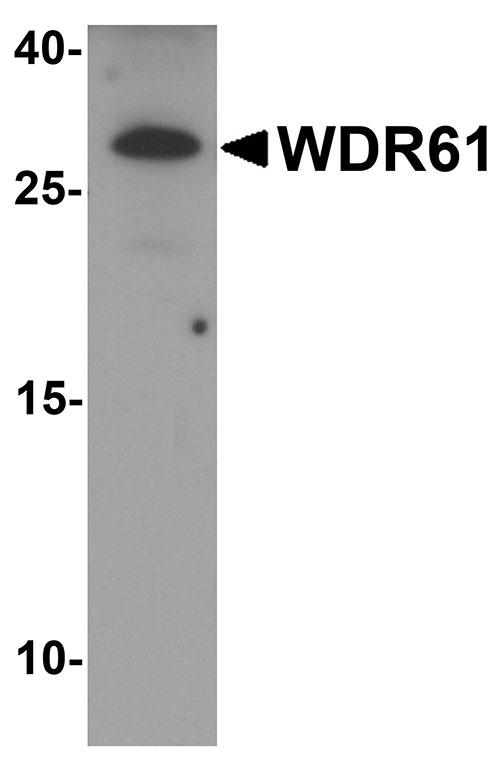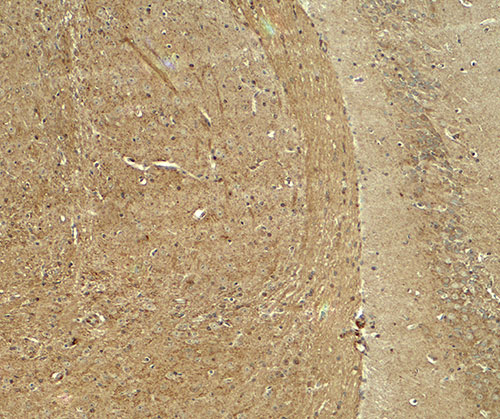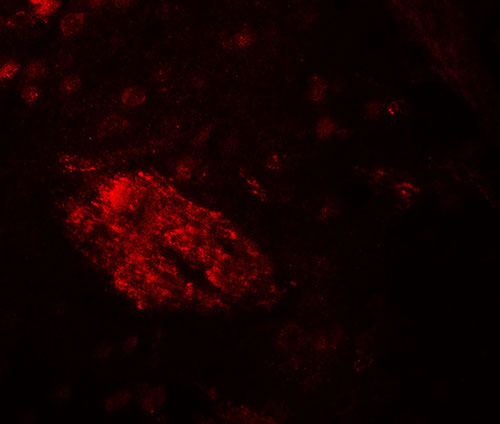WDR61 Antibody
- SPECIFICATION
- CITATIONS
- PROTOCOLS
- BACKGROUND

Application
| WB, IHC-P, IF, E |
|---|---|
| Primary Accession | Q9GZS3 |
| Other Accession | NP_079510, 13376840 |
| Reactivity | Human, Mouse, Rat |
| Host | Rabbit |
| Clonality | Polyclonal |
| Isotype | IgG |
| Calculated MW | Predicted: 34 kDa Observed: 30 kDa |
| Application Notes | WDR61 antibody can be used for detection of WDR61 by Western blot at 1 - 2 µg/ml. Antibody can also be used for immunohistochemistry starting at 5 µg/mL. For immunofluorescence start at 20 µg/mL. |
| Gene ID | 80349 |
|---|---|
| Target/Specificity | WDR61; WDR61 antibody is human, mouse and rat reactive. |
| Reconstitution & Storage | WDR61 antibody can be stored at 4℃ for three months and -20℃, stable for up to one year. |
| Precautions | WDR61 Antibody is for research use only and not for use in diagnostic or therapeutic procedures. |
| Name | SKIC8 (HGNC:30300) |
|---|---|
| Synonyms | WDR61 |
| Function | Component of the PAF1 complex (PAF1C) which has multiple functions during transcription by RNA polymerase II and is implicated in regulation of development and maintenance of embryonic stem cell pluripotency (PubMed:16307923, PubMed:19952111, PubMed:20178742). PAF1C associates with RNA polymerase II through interaction with POLR2A CTD non-phosphorylated and 'Ser-2'- and 'Ser-5'-phosphorylated forms and is involved in transcriptional elongation, acting both independently and synergistically with TCEA1 and in cooperation with the DSIF complex and HTATSF1 (PubMed:16307923, PubMed:19952111, PubMed:20178742). PAF1C is required for transcription of Hox and Wnt target genes (PubMed:16307923, PubMed:19952111, PubMed:20178742). PAF1C is involved in hematopoiesis and stimulates transcriptional activity of KMT2A/MLL1; it promotes leukemogenesis through association with KMT2A/MLL1- rearranged oncoproteins, such as KMT2A/MLL1-MLLT3/AF9 and KMT2A/MLL1- MLLT1/ENL (PubMed:16307923, PubMed:19952111, PubMed:20178742). PAF1C is involved in histone modifications such as ubiquitination of histone H2B and methylation on histone H3 'Lys-4' (H3K4me3) (PubMed:16307923, PubMed:19952111, PubMed:20178742). PAF1C recruits the RNF20/40 E3 ubiquitin-protein ligase complex and the E2 enzyme UBE2A or UBE2B to chromatin which mediate monoubiquitination of 'Lys-120' of histone H2B (H2BK120ub1); UB2A/B-mediated H2B ubiquitination is proposed to be coupled to transcription (PubMed:16307923, PubMed:19952111, PubMed:20178742). PAF1C is involved in mRNA 3' end formation probably through association with cleavage and poly(A) factors (PubMed:16307923, PubMed:19952111, PubMed:20178742). In case of infection by influenza A strain H3N2, PAF1C associates with viral NS1 protein, thereby regulating gene transcription (PubMed:16307923, PubMed:19952111, PubMed:20178742). Required for mono- and trimethylation on histone H3 'Lys-4' (H3K4me3), dimethylation on histone H3 'Lys-79' (H3K4me3). Required for Hox gene transcription (PubMed:16307923, PubMed:19952111, PubMed:20178742). Also acts as a component of the SKI complex, a multiprotein complex that assists the RNA-degrading exosome during the mRNA decay and quality-control pathways (PubMed:16024656, PubMed:32006463, PubMed:35120588). The SKI complex catalyzes mRNA extraction from 80S ribosomal complexes in the 3'-5' direction and channels mRNA to the cytosolic exosome for degradation (PubMed:32006463, PubMed:35120588). SKI-mediated extraction of mRNA from stalled ribosomes allow binding of the Pelota-HBS1L complex and subsequent ribosome disassembly by ABCE1 for ribosome recycling (PubMed:32006463). |
| Cellular Location | Nucleus. Cytoplasm |

Thousands of laboratories across the world have published research that depended on the performance of antibodies from Abcepta to advance their research. Check out links to articles that cite our products in major peer-reviewed journals, organized by research category.
info@abcepta.com, and receive a free "I Love Antibodies" mug.
Provided below are standard protocols that you may find useful for product applications.
Background
WDR61 (WD-repeat-containing protein 61), also known as SKI8 or REC14, is a subunit of the human PAF and SKI complexes, which function in transcriptional regulation and are involved in events downstream of RNA synthesis, such as RNA surveillance (1,2). PAF1C is implicated in regulation of development and maintenance of embryonic stem cell pluripotency. Component of the SKI complex which is thought to be involved in exosome-mediated RNA decay and associates with transcriptionally active genes in a manner dependent on PAF1C (3,4).
References
Zhu B, Mandal SS, Pham AD, et al. The human PAF complex coordinates transcription with events downstream of RNA synthesis. Genes Dev. 2005; 19:1668-73.
Zhu B, Zheng Y, Pham AD, et al. Monoubiquitination of human histone H2B: the factors involved and their roles in HOX gene regulation. Mol. Cell. 2005; 20:601-11.
Kim J, Guermah M, and Roeder RG. The human PAF1 complex acts in chromatin transcription elongation both independently and cooperatively with SII/TFIIS. Cell 2010; 140:491-503.
Chen Y, Yamaguchi Y, Tsugeno Y, et al. DSIF, the Paf1 complex, and Tat-SF1 have nonredundant, cooperative roles in RNA polymerase II elongation. Genes Dev. 2009; 23):2765-77.
If you have used an Abcepta product and would like to share how it has performed, please click on the "Submit Review" button and provide the requested information. Our staff will examine and post your review and contact you if needed.
If you have any additional inquiries please email technical services at tech@abcepta.com.













 Foundational characteristics of cancer include proliferation, angiogenesis, migration, evasion of apoptosis, and cellular immortality. Find key markers for these cellular processes and antibodies to detect them.
Foundational characteristics of cancer include proliferation, angiogenesis, migration, evasion of apoptosis, and cellular immortality. Find key markers for these cellular processes and antibodies to detect them. The SUMOplot™ Analysis Program predicts and scores sumoylation sites in your protein. SUMOylation is a post-translational modification involved in various cellular processes, such as nuclear-cytosolic transport, transcriptional regulation, apoptosis, protein stability, response to stress, and progression through the cell cycle.
The SUMOplot™ Analysis Program predicts and scores sumoylation sites in your protein. SUMOylation is a post-translational modification involved in various cellular processes, such as nuclear-cytosolic transport, transcriptional regulation, apoptosis, protein stability, response to stress, and progression through the cell cycle. The Autophagy Receptor Motif Plotter predicts and scores autophagy receptor binding sites in your protein. Identifying proteins connected to this pathway is critical to understanding the role of autophagy in physiological as well as pathological processes such as development, differentiation, neurodegenerative diseases, stress, infection, and cancer.
The Autophagy Receptor Motif Plotter predicts and scores autophagy receptor binding sites in your protein. Identifying proteins connected to this pathway is critical to understanding the role of autophagy in physiological as well as pathological processes such as development, differentiation, neurodegenerative diseases, stress, infection, and cancer.




